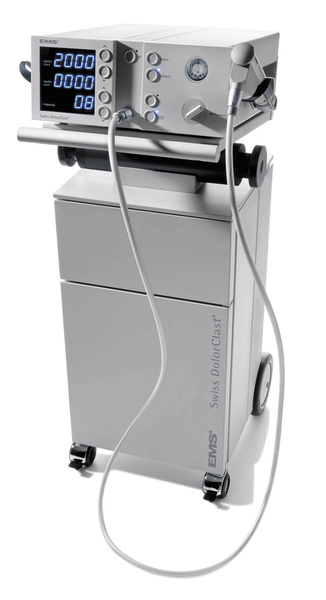
Product Name: EMS Swiss Dolorclast®
PMA Applicant: (EMS) Electro Medical Systems S.A.
Address: de la Vuarpilliere 31; CH-1260; Nyon, Switzerland
Approval Date: May 8, 2007
Approval Letter: http://www.fda.gov/cdrh/pdf5/p050004a.pdf
What is it? The EMS Swiss Dolorclast® is a non-invasive device that generates therapeutic sound waves (extracorporeal shock wave therapy) used to treat heel pain associated with chronic proximal plantar faciitis. Chronic proximal plantar faciitis is recurring inflammation of the plantar fascia, the band of connective tissue on the bottom of the foot that stretches from the base of the toes to the heel.
How does it work? The Swiss Dolorclast® consists of a control unit and a handpiece with the treatment applicator mounted on the end. The treatment applicator is held in contact with the heel. Compressed air is used to drive a projectile (metal cylinder) within the handpiece toward the applicator. When the projectile hits the applicator inside the handpiece, a shock wave is generated which is transferred to the treatment site. The highest energy density will be at the point of contact of the applicator (the treatment site), but the shockwave will travel radially outward into the soft tissue surrounding the point of contact.
When is it used? ? The Swiss Dolorclast® is indicated for the treatment of chronic proximal plantar fasciitis for patients:
- Who are 18 years of age or older
- Who have had symptoms of proximal plantar fasciitis lasting for 6 months or more
- For whom conservative therapies have failed to relieve heel pain
What will it accomplish? In a clinical study, the treatment of chronic plantar fasciitis with the Swiss Dolorclast® provided significant relief from heel pain for up to 12 weeks in patients who had failed previous conservative therapy. The most commonly reported side effect was pain during treatment, which was reported by 23 percent of subjects.
Potential adverse events when using the Swiss Dolorclast® device include:
- Bruising
- Rupture of the plantar fascia (tissue along the bottom of the foot)
- Temporary or permanent damage to the blood vessels
- Broken blood vessels visible as red or purple spots on the skin’s surface (petechia)
- Collection of blood beneath the skin’s surface resulting from internal bleeding (hematoma)
- Tendon Rupture
- Temporary or permanent nerve damage causing decreased sensitivity (hypesthesia) or abnormal skin sensations such as tingling (paresthesia)
When should it not be used? The Swiss Dolorclast® should not be used:
- Over or near bone growth center until bone growth is complete
- When a malignant disease is known to be present in or near the treatment area
- When there is an infection in the area to be treated
- Over ischemic tissue in individuals with vascular disease
- In patients who have blood clotting (coagulation) disorders or are taking anticoagulant medications
- In patients having a prosthetic device in the area to be treated
Additional information: Summary of Safety and Effectiveness and labeling will be available at: http://www.fda.gov/cdrh/pdf5/p050004.html





 留言列表
留言列表
 線上藥物查詢
線上藥物查詢 